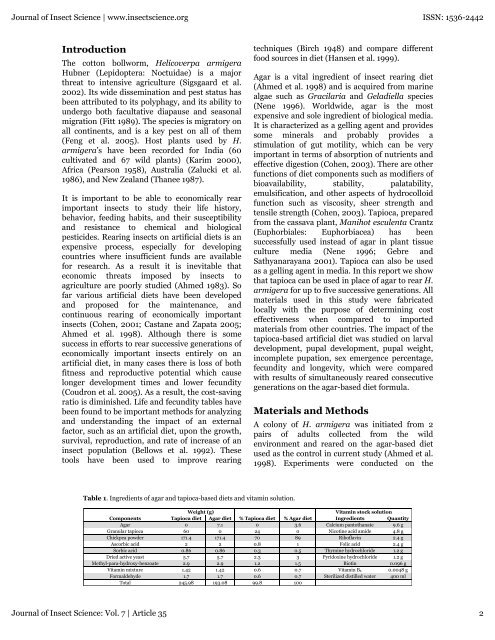Rearing the cotton bollworm, Helicoverpa armigera, on a tapioca ...
Rearing the cotton bollworm, Helicoverpa armigera, on a tapioca ...
Rearing the cotton bollworm, Helicoverpa armigera, on a tapioca ...
You also want an ePaper? Increase the reach of your titles
YUMPU automatically turns print PDFs into web optimized ePapers that Google loves.
Journal of Insect Science | www.insectscience.org ISSN: 1536-2442<br />
Introducti<strong>on</strong><br />
The <str<strong>on</strong>g>cott<strong>on</strong></str<strong>on</strong>g> <str<strong>on</strong>g>bollworm</str<strong>on</strong>g>, <str<strong>on</strong>g>Helicoverpa</str<strong>on</strong>g> <str<strong>on</strong>g>armigera</str<strong>on</strong>g><br />
Hubner (Lepidoptera: Noctuidae) is a major<br />
threat to intensive agriculture (Sigsgaard et al.<br />
2002). Its wide disseminati<strong>on</strong> and pest status has<br />
been attributed to its polyphagy, and its ability to<br />
undergo both facultative diapause and seas<strong>on</strong>al<br />
migrati<strong>on</strong> (Fitt 1989). The species is migratory <strong>on</strong><br />
all c<strong>on</strong>tinents, and is a key pest <strong>on</strong> all of <str<strong>on</strong>g>the</str<strong>on</strong>g>m<br />
(Feng et al. 2005). Host plants used by H.<br />
<str<strong>on</strong>g>armigera</str<strong>on</strong>g>’s have been recorded for India (60<br />
cultivated and 67 wild plants) (Karim 2000),<br />
Africa (Pears<strong>on</strong> 1958), Australia (Zalucki et al.<br />
1986), and New Zealand (Thanee 1987).<br />
It is important to be able to ec<strong>on</strong>omically rear<br />
important insects to study <str<strong>on</strong>g>the</str<strong>on</strong>g>ir life history,<br />
behavior, feeding habits, and <str<strong>on</strong>g>the</str<strong>on</strong>g>ir susceptibility<br />
and resistance to chemical and biological<br />
pesticides. <str<strong>on</strong>g>Rearing</str<strong>on</strong>g> insects <strong>on</strong> artificial diets is an<br />
expensive process, especially for developing<br />
countries where insufficient funds are available<br />
for research. As a result it is inevitable that<br />
ec<strong>on</strong>omic threats imposed by insects to<br />
agriculture are poorly studied (Ahmed 1983). So<br />
far various artificial diets have been developed<br />
and proposed for <str<strong>on</strong>g>the</str<strong>on</strong>g> maintenance, and<br />
c<strong>on</strong>tinuous rearing of ec<strong>on</strong>omically important<br />
insects (Cohen, 2001; Castane and Zapata 2005;<br />
Ahmed et al. 1998). Although <str<strong>on</strong>g>the</str<strong>on</strong>g>re is some<br />
success in efforts to rear successive generati<strong>on</strong>s of<br />
ec<strong>on</strong>omically important insects entirely <strong>on</strong> an<br />
artificial diet, in many cases <str<strong>on</strong>g>the</str<strong>on</strong>g>re is loss of both<br />
fitness and reproductive potential which cause<br />
l<strong>on</strong>ger development times and lower fecundity<br />
(Coudr<strong>on</strong> et al. 2005). As a result, <str<strong>on</strong>g>the</str<strong>on</strong>g> cost-saving<br />
ratio is diminished. Life and fecundity tables have<br />
been found to be important methods for analyzing<br />
and understanding <str<strong>on</strong>g>the</str<strong>on</strong>g> impact of an external<br />
factor, such as an artificial diet, up<strong>on</strong> <str<strong>on</strong>g>the</str<strong>on</strong>g> growth,<br />
survival, reproducti<strong>on</strong>, and rate of increase of an<br />
insect populati<strong>on</strong> (Bellows et al. 1992). These<br />
tools have been used to improve rearing<br />
techniques (Birch 1948) and compare different<br />
food sources in diet (Hansen et al. 1999).<br />
Agar is a vital ingredient of insect rearing diet<br />
(Ahmed et al. 1998) and is acquired from marine<br />
algae such as Gracilaria and Geladiella species<br />
(Nene 1996). Worldwide, agar is <str<strong>on</strong>g>the</str<strong>on</strong>g> most<br />
expensive and sole ingredient of biological media.<br />
It is characterized as a gelling agent and provides<br />
some minerals and probably provides a<br />
stimulati<strong>on</strong> of gut motility, which can be very<br />
important in terms of absorpti<strong>on</strong> of nutrients and<br />
effective digesti<strong>on</strong> (Cohen, 2003). There are o<str<strong>on</strong>g>the</str<strong>on</strong>g>r<br />
functi<strong>on</strong>s of diet comp<strong>on</strong>ents such as modifiers of<br />
bioavailability, stability, palatability,<br />
emulsificati<strong>on</strong>, and o<str<strong>on</strong>g>the</str<strong>on</strong>g>r aspects of hydrocolloid<br />
functi<strong>on</strong> such as viscosity, sheer strength and<br />
tensile strength (Cohen, 2003). Tapioca, prepared<br />
from <str<strong>on</strong>g>the</str<strong>on</strong>g> cassava plant, Manihot esculenta Crantz<br />
(Euphorbiales: Euphorbiacea) has been<br />
successfully used instead of agar in plant tissue<br />
culture media (Nene 1996; Gebre and<br />
Sathyanarayana 2001). Tapioca can also be used<br />
as a gelling agent in media. In this report we show<br />
that <strong>tapioca</strong> can be used in place of agar to rear H.<br />
<str<strong>on</strong>g>armigera</str<strong>on</strong>g> for up to five successive generati<strong>on</strong>s. All<br />
materials used in this study were fabricated<br />
locally with <str<strong>on</strong>g>the</str<strong>on</strong>g> purpose of determining cost<br />
effectiveness when compared to imported<br />
materials from o<str<strong>on</strong>g>the</str<strong>on</strong>g>r countries. The impact of <str<strong>on</strong>g>the</str<strong>on</strong>g><br />
<strong>tapioca</strong>-based artificial diet was studied <strong>on</strong> larval<br />
development, pupal development, pupal weight,<br />
incomplete pupati<strong>on</strong>, sex emergence percentage,<br />
fecundity and l<strong>on</strong>gevity, which were compared<br />
with results of simultaneously reared c<strong>on</strong>secutive<br />
generati<strong>on</strong>s <strong>on</strong> <str<strong>on</strong>g>the</str<strong>on</strong>g> agar-based diet formula.<br />
Materials and Methods<br />
A col<strong>on</strong>y of H. <str<strong>on</strong>g>armigera</str<strong>on</strong>g> was initiated from 2<br />
pairs of adults collected from <str<strong>on</strong>g>the</str<strong>on</strong>g> wild<br />
envir<strong>on</strong>ment and reared <strong>on</strong> <str<strong>on</strong>g>the</str<strong>on</strong>g> agar-based diet<br />
used as <str<strong>on</strong>g>the</str<strong>on</strong>g> c<strong>on</strong>trol in current study (Ahmed et al.<br />
1998). Experiments were c<strong>on</strong>ducted <strong>on</strong> <str<strong>on</strong>g>the</str<strong>on</strong>g><br />
Table 1. Ingredients of agar and <strong>tapioca</strong>-based diets and vitamin soluti<strong>on</strong>.<br />
Weight (g)<br />
Vitamin stock soluti<strong>on</strong><br />
Comp<strong>on</strong>ents Tapioca diet Agar diet % Tapioca diet % Agar diet Ingredients Quantity<br />
Agar 0 7.1 0 3.6 Calcium pantothanate 9.6 g<br />
Granular <strong>tapioca</strong> 60 0 24 0 Nicotine acid amide 4.8 g<br />
Chickpea powder 171.4 171.4 70 89 Riboflavin 2.4 g<br />
Ascorbic acid 2 2 0.8 1 Folic acid 2.4 g<br />
Sorbic acid 0.86 0.86 0.3 0.5 Thymine hydrochloride 1.2 g<br />
Dried active yeast 5.7 5.7 2.3 3 Pyridoxine hydrochloride 1.2 g<br />
Methyl-para-hydroxy-benzoate 2.9 2.9 1.2 1.5 Biotin 0.096 g<br />
Vitamin mixture 1.42 1.42 0.6 0.7 Vitamin B 1 0.0048 g<br />
Formaldehyde 1.7 1.7 0.6 0.7 Sterilized distilled water 400 ml<br />
Total 245.98 193.08 99.8 100<br />
Journal of Insect Science: Vol. 7 | Article 35 2
















